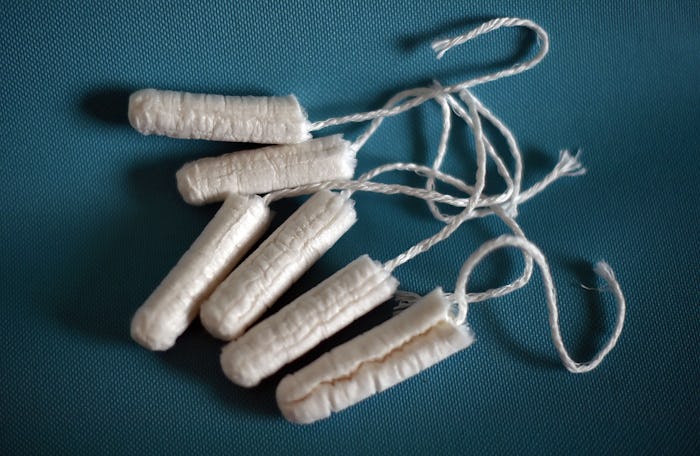Life

8 Old-School Ways Women Dealt With Their Periods
Getting your period can sometimes be a little inconvenient. But when you think about that ways women used to deal with their periods — you know, before the modern miracle known as Midol — you might start to rethink all the nasty things you've said about your time of the month. Throughout history, getting your period could be seen as anything from a nuisance to slight embarrassment to overwhelming shame.
Commercially-available sanitary pads as they're known today didn't come to be until after World War I. According to Smithsonian Magazine, the first box of cellulose-based Kotex sanitary pads was sold in 1919 at Woolworth's department store in Chicago. Not only that, but the modern-day tampon wasn't made commercially available until 1933, according to The Atlantic. All of these products, of course, were only truly available to the women who were wealthy enough to afford them. Prior to these inventions, women had far fewer effective choices when it came to dealing with their periods, some of which were culturally-mandated and really no choice at all.
Next time you get ready to complain about tampons or pads that feel like diapers (I'm right there with you), just think about what you'd have to do if those weren't available. Getting your period can be inconvenient, but getting your period without feminine hygiene products would be even worse.
1They Isolated Themselves
According to Medical Daily, ancient Hebrew women were isolated during menstruation and only allowed to rejoin society after seven days. This practice stemmed from the belief that menstruating women were unclean and so should not be functioning within their communities while they were on their period.
Unfortunately, in some parts of India, women are still isolated during their periods because they're viewed as unclean, according to the BBC.
2They Used A Form Of Pads And Tampons
According to The Curse: A Cultural History of Menstruation, women got quite creative when it came to early "tampons." From paper in ancient Japan, to vegetable fibers in Indonesia, to wool in ancient Rome, to grass and roots in Equatorial Africa, women created tampons from whatever they had access to in their surrounding environments.
3The Used Rags
Yes, this where the term "on the rag" comes from. According to the aforementioned article from Medical Daily, many women in the Middle Ages used torn up rags to absorb menstrual blood. Pioneering American women also used rags, according to The Salt Lake Tribune. This is still a common solution around the world, particularly in areas where commercially-available products aren't affordable or just aren't, well, available.
4They Bled Into Their Clothing
The previously-mentioned Medical Daily article also noted that, rather than using either rags or other absorbent items, some medieval women would simply bleed into their clothing whenever they were on their periods. If you don't have other options, free-bleeding into clothing is all you're able to do.
5The Wore Rubber "Aprons"
In the 1850s, so-called rubber aprons were the norm when it came to dealing with periods. In an interview withWomen's Health, Sharra Vostral, an associate professor of history at Purdue University, said that women wore pieces of rubber between their bloomers and skirt while they were on their periods, which were heavy and likely didn't smell all that lovely. Essentially, these rubber aprons prevented any leakages when women sat down.
6They Donned A Sanitary Belt
Sanitary belts were the norm until the invention of Stayfree's sanitary pad with an adhesive strip in 1969, as noted by Women's Health. Sanitary belts, like the Hoosier belt, were, when first invented, made of metal, according to the aforementioned Medical Daily article. Luckily, for the most part, sanitary belts were mostly phased out by the 1980s.
7They Would Wear Burn Toads
According to Metro (UK), medieval historian Amy License wrote that, in the Middle Ages, women would wear burnt toad ashes near their vagina to try to deal with a heavier flow. As far as I know, that's no longer a commonly-used remedy for heavy flow, at least in the United States.
8They Used Sponges
According to The Atlantic, the development of the original compressed cotton applicator stems from Dr. Earle Cleveland Haas' friend, who told him that she was inserting a sponge to absorb period blood during that time of the month. He invented the modern applicator tampon as a solution to avoid bulky pads, the need to touch the tampon during insertion, and the need to use any other products to intravaginally absorb menstrual blood. Haas patented the tampon in 1933, so the next time you use a tampon and don't have to bother with the more old-school period solutions of the past, say a tiny "thank you" to Dr. Haas.